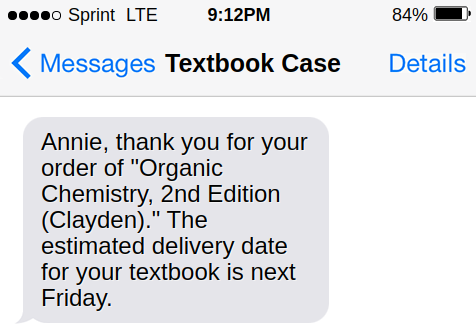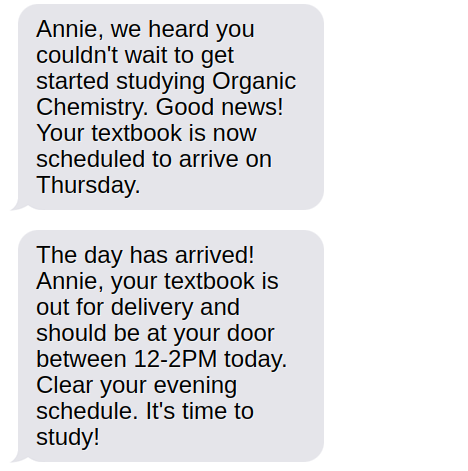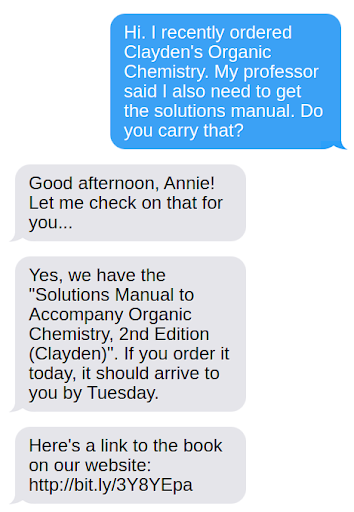What is conversational marketing?
Time to read:
Conversational marketing is a customer-centric marketing approach in which businesses interact with customers one-on-one in real time. Businesses that adopt a traditional marketing approach might broadcast a general message to a large audience hoping to attract a few interested leads. In contrast, conversational marketing uses direct and personalized conversations to make each customer feel heard and valued.
Here, we’ll look at the importance of conversational marketing and its benefits. Then, we’ll explore conversational marketing examples, such as SMS and chatbots. Finally, we’ll provide some guidelines for how to effectively integrate conversational marketing into your overall strategy.
Let’s dive in.
Why is conversational marketing important?
The customer experience you provide will directly impact your business’ success. So if you want to foster genuine connections with your customers, a conversational marketing strategy is essential. There are three primary reasons why.
First, modern consumers have high expectations for the speed and quality of service that businesses provide. They expect instantaneous, accurate, and always-available support. Additionally, they want to feel valued and understood. Conversational marketing meets consumer expectations for personalized and immediate communication by providing real-time personalized responses.
Second, relationships—not transactions—lie at the heart of any successful business, and conversational marketing facilitates a meaningful, two-way dialogue with customers. This open communication strengthens customer relationships through meaningful engagement, allowing businesses to build trust and rapport that fosters customer loyalty over time.
Finally, traditional marketing methods often cast a wide net hoping to win over some customers, which can waste time and resources. Conversely, conversational marketing targets individual customers with tailored messaging, a tactic that drives business growth by increasing conversion rates. By engaging customers individually and in real time, businesses can address questions promptly, accelerating the customer journey from interest to purchase.
In short, conversational marketing is more than necessary. It’s critical. Let’s continue by exploring some examples and benefits.
Conversational marketing examples
Unlike traditional marketing, conversational marketing has many forms and is personalized to the target audience. Businesses use these methods to improve customer engagement and retention. Let’s take a look at some popular conversational marketing examples.
1. Chatbots
Chatbots can engage customers in multiple ways, including basic customer support, lead generation, customer satisfaction surveys, and product availability and recommendations. Additionally, chatbots can personalize recommendations to users, help mitigate long wait times, provide support outside of business hours, and reduce costs for businesses.
2. Live chat
Live chat allows customers to connect with customer support agents directly on a business’ website for issues that arise and need more tailored support than a chatbot. Agents can message customers directly to provide support and send direct links and instructions.
3. Messaging apps
Messaging apps, such as Facebook Messenger, WhatsApp, and Instagram, are organic and paid channels to engage prospective customers.
A prospective customer can send your brand a message via Facebook Messenger while viewing your Facebook page. On Instagram, customers can message you directly, or you can add a click-to-message link in your Instagram bio. This link will take prospective customers directly to WhatsApp, where they can message you to learn more about your business.
Many brands also run paid click-to-message ads on Facebook and Instagram to connect with customers via WhatsApp. A prospective customer can reach you directly by clicking a link from that advertisement. Learn more about setting up click-to-message ads for WhatsApp.
4. Text messages
Text messages are part of many businesses’ conversational marketing strategies. One example is sending a personalized text message with tracking information for a recent order shipment.
Some brands also choose to run click-to-text ad campaigns or use click-to-text links in email marketing efforts. When a customer clicks on one of these links, their texting app opens and shows a pre-populated message to the brand’s phone number. Learn more about engaging customers with click-to-text.
Benefits of conversational marketing
Conversational marketing is advantageous for business operations and customer experiences alike. Here are three of the top benefits:
1. Enhanced customer satisfaction and loyalty
Tailored communications to the individual help businesses form more personal connections, which leads to customers feeling valued. This increases customer satisfaction and deeper brand loyalty.
2. Improved customer insights for better decision-making
Communicating directly with customers helps businesses gain access to a wealth of first-party data. By mining this data for insights, businesses can understand customer behavior, preferences, and pain points better. This leads to better data-driven decision-making.
3. Efficient and effective customer service
Conversational marketing can significantly improve the quality of businesses’ customer service by providing immediate, real-time responses. This results in quicker resolution of customer issues and reduced wait times.
What does conversational marketing look like when applied to SMS marketing or chatbots? Let’s shift our focus to consider these two angles.
Conversational SMS marketing
SMS holds several advantages that make it ideal for a conversational marketing strategy. These key advantages include:
- Reach: SMS is highly accessible to reach a broad audience since most consumers own a mobile device.
- Immediacy: SMS messages are typically read within minutes of receipt, ensuring that your message gets to your audience promptly.
- Engagement: SMS is more personal and direct, leading to higher engagement rates compared to other marketing channels. In fact, the average open rate for SMS marketing messages is 82%.
Now, let’s consider an example: Annie is a customer who purchased a product from your online store. Within seconds of completing her purchase, she receives a personalized SMS message to thank her for her purchase and provide an estimated delivery date.

Over the next few days, Annie receives personalized updates about her order status.

Additionally, when Annie reaches out with an inquiry, she receives a timely and helpful response.

From these interactions, Annie feels valued and connected to your business. Her enhanced customer experience will increase her loyalty and the likelihood of future purchases.
Chatbots and conversational marketing
As indicated earlier, chatbots also play a key role in conversational marketing, offering availability, personalization, and human-like interactions.
Unlike human support agents, your chatbots don't require rest or have limited working hours. This means your business can leverage chatbots to facilitate 24/7 customer interaction. Your business can engage with customers in real time, anytime, promptly addressing customer inquiries and consistently meeting customer needs.
AI and automation also enable modern chatbots to deliver personalized and timely responses. Chatbots can analyze customer data to understand their behavior and preferences, then tailor the responses accordingly. This can potentially lead to an AI-powered chatbot being more successful at delivering effective customer personalization than a human agent.
However, businesses must balance using chatbots with human-led interactions. Even with advancements in generative AI to provide human-like interactions, addressing a complex issue or providing a more empathetic response require a human touch.
Therefore, creating a balance between automated and human-led interactions is crucial. Effective conversational marketing strategies often use chatbots for initial interactions and common queries, then transition to human assistance when the interaction requires more nuanced understanding or decision-making.
Now that we’ve considered how to think about conversational marketing in the context of SMS or chatbots, let’s transition to some helpful best practices.
Conversational marketing best practices
As you get started, consider the following best practices for conversational marketing:
1. Align your conversational marketing with overall business goals
Every business has goals for its marketing strategy: build brand awareness, boost sales, improve customer satisfaction, and so on. When you adopt a conversational marketing approach, ensure that your efforts directly contribute to achieving your overall business goals. Otherwise, you may only pursue conversational marketing in the short term because of its novelty.
Aligning conversational marketing and your overall business goals ensures your business will take a focused approach. Additionally, you can measure the success of your initiatives by analyzing the direct impact on your business goals.
2. Segment your audiences for personalized communication
As we’ve noted, one of the significant advantages of conversational marketing is engagement with your customers through personalized, one-to-one interactions. However, effectively leveraging this requires you to segment your audiences appropriately.
You might segment your audience based on factors such as demographics, buying behavior, or preferences—any of which will have a significant bearing on how you personalize your communication. Then, after segmenting your audiences, you can tailor your messages to resonate with each segment. The result will be more engaging and fruitful customer interactions.
3. Ensure a seamless transition between marketing channels
Increasingly, customers expect an omnichannel experience in interactions with businesses. For businesses, this means being available, reaching out across multiple channels—social media, email, voice, chat, SMS, and more—and providing a consistent experience across these channels.
To properly leverage conversational marketing, your business must maintain the momentum of a customer conversation, even if the customer switches from SMS to a chatbot to a video call with a human support agent. By providing a seamless transition between channels, you communicate to the customer that you hear, understand, and value them, building deep customer trust.
Build an effective conversational marketing strategy with Twilio
Now that you know conversational marketing builds real-time, personalized, and engaging interactions with customers in contrast to traditional marketing strategies, it’s time to build one for your business. Twilio has the tools to help you implement conversational marketing using SMS and chatbots, vehicles that extend businesses’ reach while meeting the customers’ expectations for immediacy and availability.
When you’re ready to take your first step, take a look at Twilio MessagingX, a centralized messaging platform that enables you to engage your customers on their channels of choice.
By using Twilio’s Programmable Messaging API and Conversations API, you can quickly get to market with globally scalable conversational messaging. To get started, sign up for a free account today.
Related Posts
Related Resources
Twilio Docs
From APIs to SDKs to sample apps
API reference documentation, SDKs, helper libraries, quickstarts, and tutorials for your language and platform.
Resource Center
The latest ebooks, industry reports, and webinars
Learn from customer engagement experts to improve your own communication.
Ahoy
Twilio's developer community hub
Best practices, code samples, and inspiration to build communications and digital engagement experiences.


